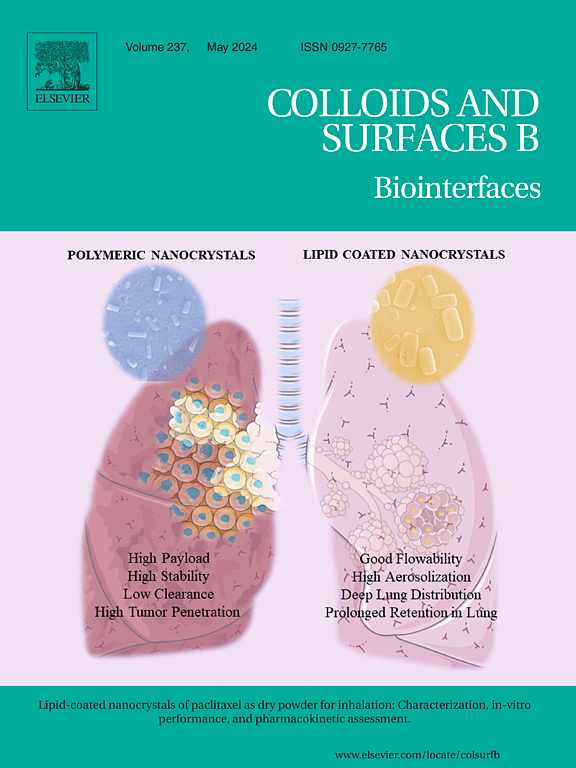Dopamine-mediated Immobilization of Antimicrobial Peptides on Stainless Steel for Marine Antifouling Applications
IF 5.6
2区 医学
Q1 BIOPHYSICS
引用次数: 0
Abstract
Biofouling due to marine microorganism adhesion poses significant challenges for marine vessels, necessitating innovative antifouling solutions. This study aimed to investigate the antifouling performance of an antimicrobial peptides (AMPs) immobilized on dopamine-modified stainless steel (SS) surfaces, as a novel approach for antifouling applications. Herein, dopamine was utilized to form a modification layer on SS, subsequently immersed in AMPs solution to create SS-DA-A samples. The surface characteristics were characterized through X-ray photoelectron spectroscopy (XPS), field emission scanning electron microscopy (FESEM), contact angle measurement instrument, fourier transform infrared spectroscopy (FTIR), and confocal laser scanning microscopy (CLSM). Antimicrobial properties were assessed using plate counting, measuring bacterial adhesion, and optical density value, while algal resistance was determined through SEM and CLSM methods, specifically assessing the coverage by algae. The results demonstrated the successful modification of the SS surface, characterized by FTIR peaks corresponding to AMPs, and a significant reduction in contact angle with the introduction of dopamine. Notably, the SS-DA-A surface exhibited enhanced antimicrobial efficacy against Vibrio natriegens (V. natriegens), Staphylococcus aureus (S. aureus), and Escherichia coli (E. coli), with a marked reduction in biofilm formation, and C. pyrenoidosa and P. tricornutum coverage decreased by approximately 96.46 % and 91.61 %, respectively. Molecular dynamics simulation results reveal that antimicrobial peptides interact with the bacterial phospholipid bilayer, disrupting bacterial integrity and thus achieving surface antimicrobial activity. This study effectively demonstrates that dopamine facilitates the successful immobilization of AMPs on SS surfaces, leading to significantly improved antibacterial, anti-algal, and biofilm resistance properties, and offers a promising new strategy for antifouling technology in marine settings.
多巴胺介导的抗菌肽在不锈钢上的固定化及其海洋防污应用
由于海洋微生物附着造成的生物污染给船舶带来了重大挑战,因此需要创新的防污解决方案。本研究旨在研究多巴胺修饰不锈钢(SS)表面固定化抗菌肽(AMPs)的防污性能,作为一种新型的防污方法。在这里,多巴胺在SS上形成修饰层,然后浸泡在amp溶液中,得到SS- da - a样品。通过x射线光电子能谱(XPS)、场发射扫描电镜(FESEM)、接触角测量仪、傅里叶变换红外光谱(FTIR)和共聚焦激光扫描显微镜(CLSM)对其表面特征进行了表征。通过平板计数、测量细菌粘附力和光密度值来评估抗菌性能,通过SEM和CLSM方法来确定藻类耐药性,具体评估藻类的覆盖范围。结果表明,SS表面的修饰成功,其特征是与amp对应的FTIR峰,并且随着多巴胺的引入,接触角显著降低。值得注意的是,SS-DA-A表面对产氮弧菌(V. natriegens)、金黄色葡萄球菌(S. aureus)和大肠杆菌(E. coli)的抗菌效果增强,生物膜的形成明显减少,pyrenoidosa和tricornutum的覆盖率分别下降了约96.46 %和91.61 %。分子动力学模拟结果表明,抗菌肽与细菌磷脂双分子层相互作用,破坏细菌完整性,从而实现表面抗菌活性。该研究有效地证明了多巴胺促进了amp在SS表面的成功固定,从而显著提高了抗菌、抗藻和生物膜抗性性能,并为海洋环境中的防污技术提供了一种有前途的新策略。
本文章由计算机程序翻译,如有差异,请以英文原文为准。
求助全文
约1分钟内获得全文
求助全文
来源期刊

Colloids and Surfaces B: Biointerfaces
生物-材料科学:生物材料
CiteScore
11.10
自引率
3.40%
发文量
730
审稿时长
42 days
期刊介绍:
Colloids and Surfaces B: Biointerfaces is an international journal devoted to fundamental and applied research on colloid and interfacial phenomena in relation to systems of biological origin, having particular relevance to the medical, pharmaceutical, biotechnological, food and cosmetic fields.
Submissions that: (1) deal solely with biological phenomena and do not describe the physico-chemical or colloid-chemical background and/or mechanism of the phenomena, and (2) deal solely with colloid/interfacial phenomena and do not have appropriate biological content or relevance, are outside the scope of the journal and will not be considered for publication.
The journal publishes regular research papers, reviews, short communications and invited perspective articles, called BioInterface Perspectives. The BioInterface Perspective provide researchers the opportunity to review their own work, as well as provide insight into the work of others that inspired and influenced the author. Regular articles should have a maximum total length of 6,000 words. In addition, a (combined) maximum of 8 normal-sized figures and/or tables is allowed (so for instance 3 tables and 5 figures). For multiple-panel figures each set of two panels equates to one figure. Short communications should not exceed half of the above. It is required to give on the article cover page a short statistical summary of the article listing the total number of words and tables/figures.
 求助内容:
求助内容: 应助结果提醒方式:
应助结果提醒方式:


